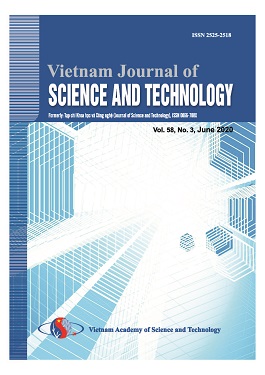Sterols and flavone from the leaves of Vernonia amygdalina growing in Thua Thien Hue
Author affiliations
DOI:
https://doi.org/10.15625/2525-2518/56/6/12584Keywords:
Vernonia amygdalina, sterol, vernoniamygda A, vernoniamygda B, luteolinAbstract
By using various chromatographic methods, two sterols and one flavone, vernoniamygda A (1), vernoniamygda B (2), and luteolin (3) were isolated from the methanol extract of the leaves of Vernonia amygdalina. Their structures were determined using 1D, 2D-NMR and ESI-MS analysis as well as by comparison with the reported data. Compounds 1 and 2 were reported from natural for the first time.
Downloads
References
Atangwho, I. J., Ebong, P. E., Eyong, E. U., Asmawi, M. Z., Ahmad, M., 2012. Synergistic antidiabetic activity of Vernonia amygdalina and Azadirachta indica: Biochemical effects and possible mechanism. Journal of Ethnopharmacology, 141(3), 878-887.
Quasie, O., Zhang, Y.-M., Zhang, H.-J., Luo, J., Kong, L.-Y., 2016. Four new steroid saponins with highly oxidized side chains from the leaves of Vernonia amygdalina. Phytochemistry Letters, 15 16-20.
Toyang, N. J., Verpoorte, R., 2013. A review of the medicinal potentials of plants of the genus Vernonia (Asteraceae). Journal of Ethnopharmacology, 146(3), 681-723.
Adedapo, A. A., Aremu, O. J., Oyagbemi, A. A., 2014. Anti-Oxidant, Anti-Inflammatory and Antinociceptive Properties of the Acetone Leaf Extract of Vernonia mygdalina in Some Laboratory Animals. Advanced Pharmaceutical Bulletin, 4 591-598.
Tona, L., Cimanga, R. K., Mesia, K., Musuamba, C. T., Bruyne, T. D., Apers, S., Hernans, N., Van Miert, S., Pieters, L., Totté, J., Vlietinck, A. J., 2004. In vitro antiplasmodial activity of extracts and fractions from seven medicinal plants used in the Democratic Republic of Congo. Journal of Ethnopharmacology, 93(1), 27-32.
Ayoola, G., Coker, H., Adesegun, S., Adepoju-Bello, A., Obaweya, K., C. Ezennia, E., Atangbayila, T., 2008. Phytochemical Screening and Antioxidant Activities of Some Selected Medicinal Plants Used for Malaria Therapy in Southwestern Nigeria. 1019-1024
Nwanjo, H. U., 2005. Efficacy of aqueous leaf extract of Vernonia amygdalina on plasma lipoprotein and oxidative status in diabetic rat models. Nigerian Journal of physiological Sciences, 20(1-2), 39-42.
Longanga Otshudi, A., Vercruysse, A., Foriers, A., 2000. Contribution to the ethnobotanical, phytochemical and pharmacological studies of traditionally used medicinal plants in the treatment of dysentery and diarrhoea in Lomela area, Democratic Republic of Congo (DRC). Journal of Ethnopharmacology, 71(3), 411-423.
Ogundipe, O. O., Moody, J. O., Akinyemi, T. O., Raman, A., 2003. Hypoglycemic potentials of methanolic extracts of selected plant foods in alloxanized mice. Plant Foods for Human Nutrition, 58(3), 1-7.
Yeap, S. K., Ho, W. Y., Beh, B. K., Liang, W. S., Ky, H., Yousr, A. H. N., Alitheen, N. B., 2010. Vernonia amygdalina, an ethnoveterinary and ethnomedical used green vegetable with multiple bio-activities. Journal of Medicinal Plants Research, 4(25), 2787-2812.
Taiwo, I. A., Godwin, P., Odeigah, C., Jaja, S. I., Mojiminiyi, F. B., 2009. Cardiovascular effects of Vernonia amygdalina in rats and the implications for treatment of hypertension in diabetes. Researcher, 2 76-79.
Atangwho, I. J., Egbung, G. E., Ahmad, M., Yam, M. F., Asmawi, M. Z., 2013. Antioxidant versus anti-diabetic properties of leaves from Vernonia amygdalina Del. growing in Malaysia. Food Chemistry, 141(4), 3428-3434.
Liu, J., Liu, Y., Si, Y., Yu, S., Qu, J., Xu, S., Hu, Y., Ma, S., 2009. New vernocuminosides from the stem barks of Vernonia cumingiana Benth. Steroids, 74(1), 51-61.
Jisaka, M., Ohigashi, H., Takegawa, K., Hirota, M., Irie, R., Huffman, M., Koshimizu, K., 1993. Steroid glucosides from Vernonia amygdalina, a possible chimpanzee medicinal plant.
Jisaka, M., Ohigashi, H., Takagaki, T., Nozaki, H., Tada, T., Hirota, M., Irie, R., Huffman, M. A., Nishida, T., Kaji, M., Koshimizu, K., 1992. Bitter steroid glucosides, vernoniosides A1, A2, and A3, and related B1 from a possible medicinal plant, Vernonia amygdalina, used by wild chimpanzees. Tetrahedron, 48(4), 625-632.
Youssef, D., Frahm, A. W., 1995. Constituents of the Egyptian Centaurea scoparia; III. Phenolic Constituents of the Aerial Parts. Planta Med, 61(06), 570-573.
Downloads
Published
How to Cite
Issue
Section
License

This work is licensed under a Creative Commons Attribution-ShareAlike 4.0 International License.
Vietnam Journal of Sciences and Technology (VJST) is an open access and peer-reviewed journal. All academic publications could be made free to read and downloaded for everyone. In addition, articles are published under term of the Creative Commons Attribution-ShareAlike 4.0 International (CC BY-SA) Licence which permits use, distribution and reproduction in any medium, provided the original work is properly cited & ShareAlike terms followed.
Copyright on any research article published in VJST is retained by the respective author(s), without restrictions. Authors grant VAST Journals System a license to publish the article and identify itself as the original publisher. Upon author(s) by giving permission to VJST either via VJST journal portal or other channel to publish their research work in VJST agrees to all the terms and conditions of https://creativecommons.org/licenses/by-sa/4.0/ License and terms & condition set by VJST.
Authors have the responsibility of to secure all necessary copyright permissions for the use of 3rd-party materials in their manuscript.







 Vietnam Journal of Science and Technology (VJST) is pleased to notice:
Vietnam Journal of Science and Technology (VJST) is pleased to notice: